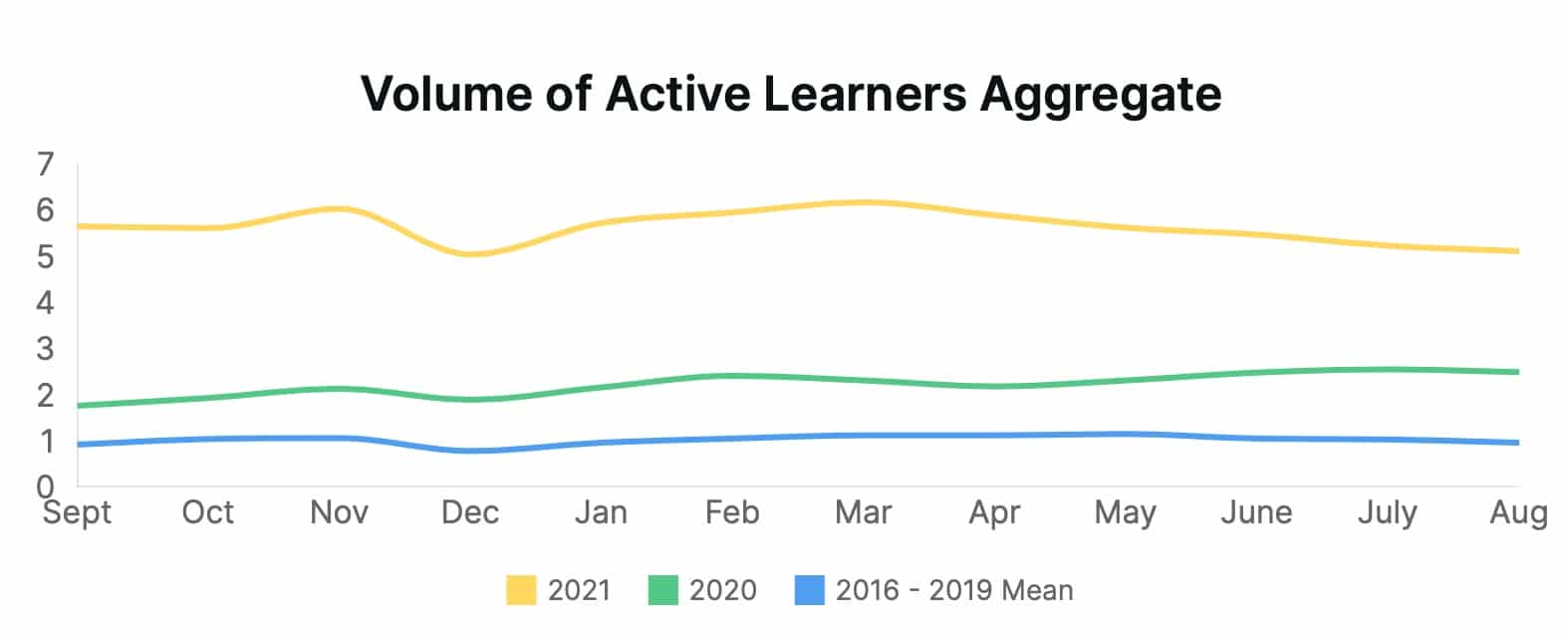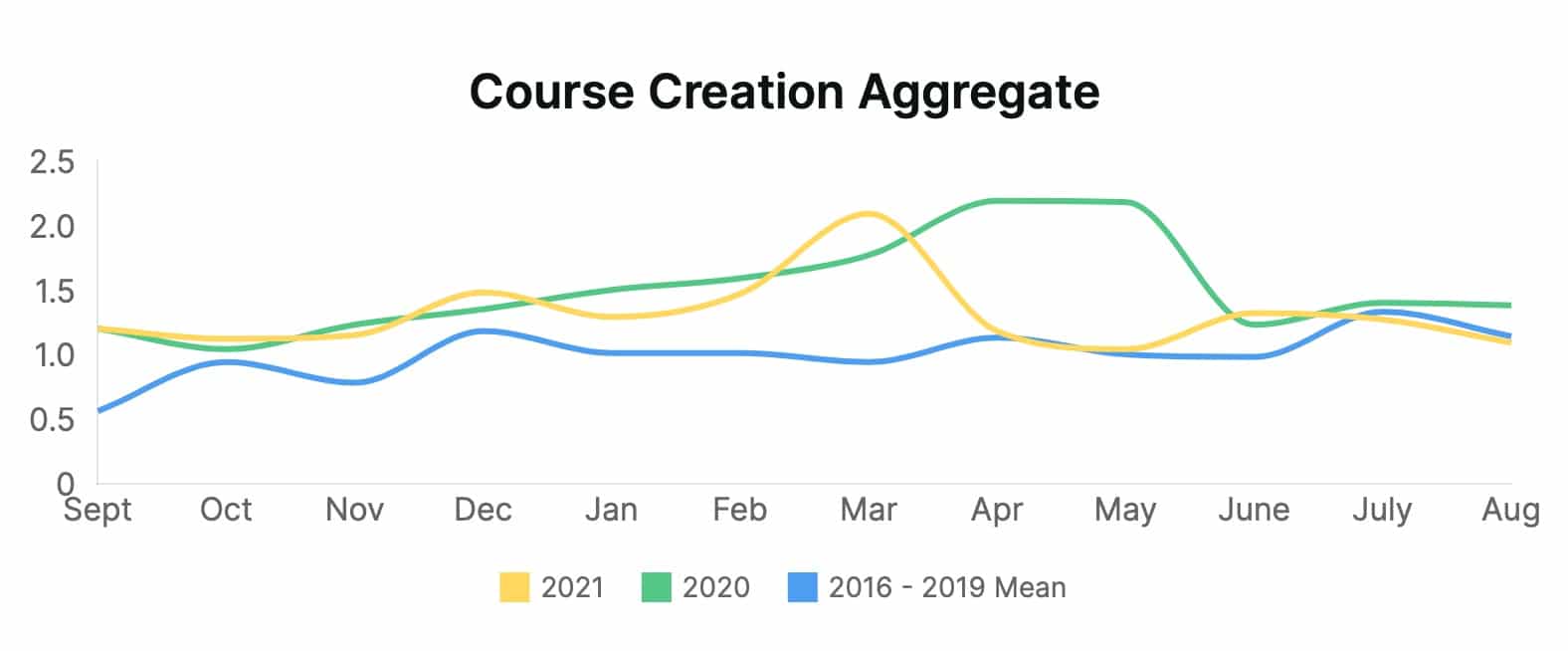Training Volume is Rising in 2021 – Here’s How Top Teams Are Adapting
We’ve recently published the Administrate 2021 Enterprise Training Trends & Insights Report. Using data from 170+ training teams, and representing 2.4 million learners, the report digs deep into trends that shaped 2021. This blog explores one of those trends: why effective training operations are so important as we emerge from the COVID era.
Training has led enterprise through the relentless challenges of the COVID-19 pandemic. At the time of this writing, that’s been a solid 20 months. Now as we close into the last quarter of 2021, there’s evidence that many trends that emerged in 2020 as a result of the pandemic are sticking around.
One of those trends can become a burden on training teams: a sharp, sustained increase in the numbers of learning seeking training.
The Data Shows Training Volume is Spiking
Our data, which is anonymized, revealed there were more events scheduled, more emails sent, more of just about everything to manage in 2021. The usual problems surrounding enrollment, course management, and scheduling have turned into real barriers to training performance all because of the sheer volume of learners seeking training.

Interestingly enough, this spike in training volume doesn’t correspond to an uptick in new courses created. This suggests that training teams are pushing more learners through the core curriculum. This pressure can cause serious issues on training teams that aren’t prepared to meet the demand, causing bottlenecks and performance drops that can be attributed to inefficient processes.
This looks like late nights manually managing course enrollments, juggling schedules, and answering learner questions about their courses. It means more emails sent more often, with a growing amount of information to account for different training modalities. This pressure can cause rapid breakdowns in scheduling, especially in enterprises that have tight scheduling requirements such as manufacturing. However, top training teams are making strategic investments in automation that can help scale resources to meet rising demand.

See Our Complete Analysis
Why Training Volume is Trending Up
There is no single cause we can identify as a primary driver of this training volume spike but there are some powerful forces transforming the workforce. In fact, there’s evidence to suggest elevated training volume will be sustained throughout 2022 and beyond. This may be the new normal.
The Great Resignation
Countless articles, surveys, and think pieces on what Texas A&M professor, Anthony Klotz termed “The Great Resignation.” There is little doubt that a large chunk of the workforce – across many industries – decided to find new work in 2021.
Being in lockdown, faced with burnout, many people decided to move on from their current position. Large transitions in the workforce of course drive training volume as people land in new positions or even entirely new careers, requiring onboarding. Meanwhile, remaining employees require upskilling or reskilling to fill gaps in the enterprise or master new skills.
There’s evidence to suggest elevated training volume will be sustained through 2022 and beyond. This might be the new normal.
Emerging Professions on the Rise
The pandemic has only accelerated a historical trend pushing employees to seek upskilling or reskilling in the face of changing markets. The World Economic Forum’s Future of Jobs Report 2020, forecasts that as soon as 2025, the percentage of jobs that are no longer relevant (or could be replaced with automation) will decline sharply from 15.4% to 9%. Over that same period, emerging professions will almost double from 7.8% to 13.5%.
New Priorities from Young Professionals
Data suggests generational change is pushing training volume as well. According to the LinkedIn 2021 Workplace Learning Report 76% of Gen Z learners believe that continuous learning and development is the key to a successful career. Furthermore, this generation is consuming more learning content more quickly across all modalities.
Training is now being seen as a competitive advantage for many companies, and our own data shows that training companies (organizations that provide training for profit) have seen a boost in revenue over 2021 that corresponds well to the increased training volume.
What You Can Do to Adapt to Higher Training Volume
Training has always played a vital role in the success or failure of their organization, and that leadership has only been underscored during the COVID era. Data suggests the pandemic has also crystalized new trends that require the training function to be flexible, highly adaptable, and scalable.
Investing in training management software that empower training teams to achieve that high degree of flexibility is going to be required to keep pace with these new trends. Here’s what you can do now to prepare to meet sustained training demand.
Evaluate Learning Technology and Strategy for Resilience
Training teams depend on their learning tech to pivot to face new business challenges. You can start by evaluating your own learning tech for resilience. Many teams will find they have a hodgepodge of disconnected pieces of learning technology that do not work as a single, cohesive training management system. When there is a spike in training volume, the gaps in this approach become blockers.
Technology is only one half of the solution, top teams are also evaluating their strategy as well. Resilient training teams are able to connect training outcomes directly to organizational goals. They work to build a complete view of their program, using training data to understand what is working and to identify opportunities.
Leverage Learning Analytics to be Proactive
Teams that can scale and handle pressure to training operations don’t do it alone: they rely heavily on data-driven decision making.
A mature data model of your training function allows you to forecast demand before it hits, giving you more time to plan. Better data management is paired with better reporting so you can share training’s impact – and requirements – across your organization. When you can show how you impact organizational goals, it’s easier to leverage that data into a request for more budget or additional resources.
Better learning analytics can take many forms, from improving your existing spreadsheets to implementing a robust training data and operations platform like Administrate. We have an ebook that can help you design learning analytics that empower your team to scale.
Consider a Training Management System
Administrate is a robust training management system that helps you manage every aspect of training. Training management systems are built to solve operational problems by reducing manual tasks, improving reporting, and capturing and analyzing training data. Not every team is ready for a training management system. As you evaluate your existing technology, also evaluate the benefits and requirements that a platform like Administrate can offer.
Training Operations Will be Critical in 2022
All of this data points to a clear pattern: training operations will be critical in 2022. Teams that are still mired in manual workarounds, pulling long hours processing enrollments by hand, and falling behind with credentialing and compliance are going to be at extreme risk as high volume is sustained in 2022.
We suggest anyone that is feeling the pinch now evaluate their fundamentals: technology, processes, and learning analytics to prepare for 2022.











